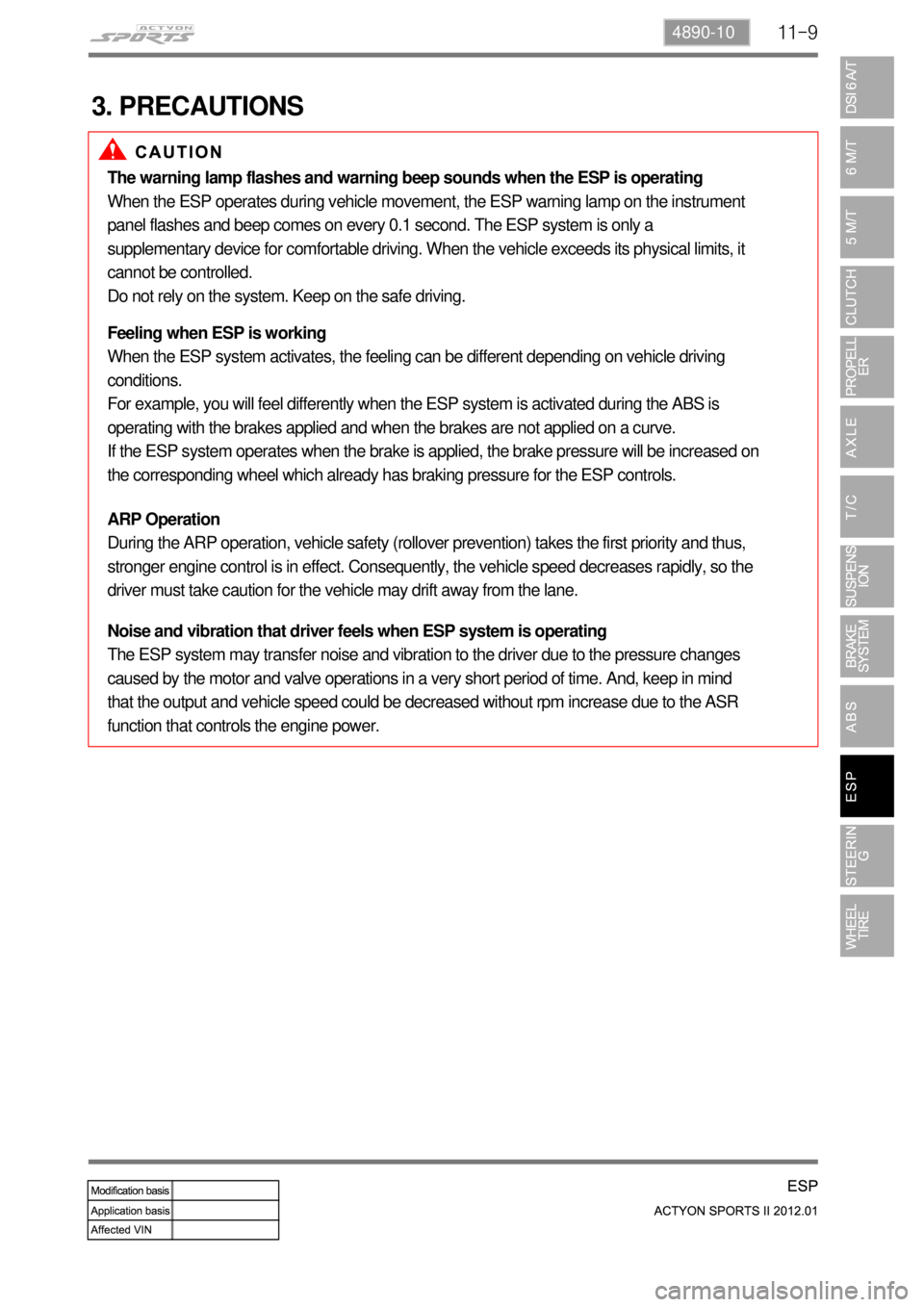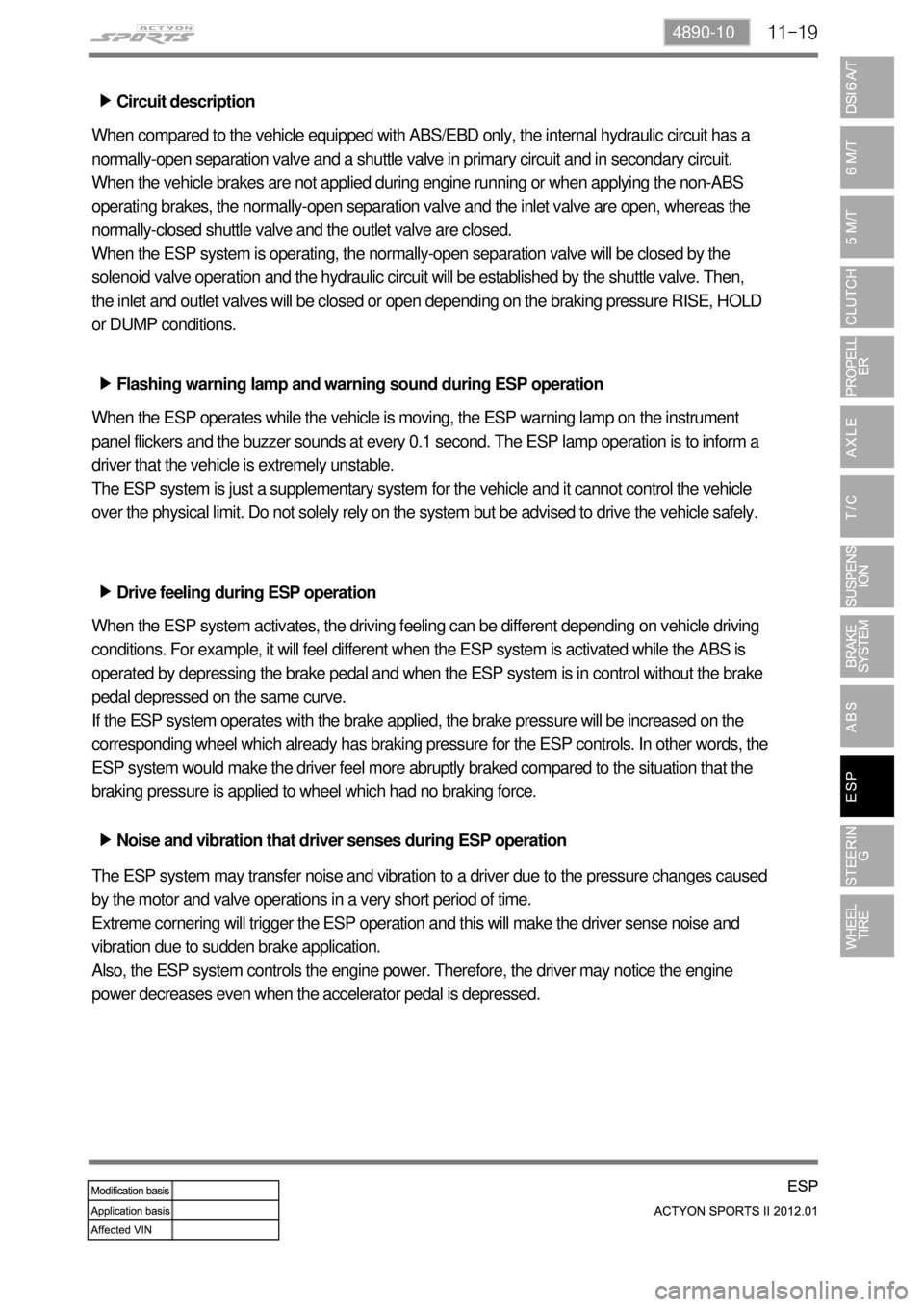Page 709 of 828
11-8
ESP OFF switch
Located on the left side of
instrument panel.
Rear wheel speed sensor
Located on the both ends of
rear axle.Front wheel speed sensor
Located on the hub
assembly.Sensor cluster
Located at the bottom of
center fascia panel.
Steering wheel angle sensor
Located on column shaft with
contact coil.HECU assembly
Located near the brake
booster in engine
compartment and contains
the pressure sensor.
2. COMPONENTS
Page 710 of 828

11-94890-10
3. PRECAUTIONS
The warning lamp flashes and warning beep sounds when the ESP is operating
When the ESP operates during vehicle movement, the ESP warning lamp on the instrument
panel flashes and beep comes on every 0.1 second. The ESP system is only a
supplementary device for comfortable driving. When the vehicle exceeds its physical limits, it
cannot be controlled.
Do not rely on the system. Keep on the safe driving.
Feeling when ESP is working
When the ESP system activates, the feeling can be different depending on vehicle driving
conditions.
For example, you will feel differently when the ESP system is activated during the ABS is
operating with the brakes applied and when the brakes are not applied on a curve.
If the ESP system operates when the brake is applied, the brake pressure will be increased on
the corresponding wheel which already has braking pressure for the ESP controls.
ARP Operation
During the ARP operation, vehicle safety (rollover prevention) takes the first priority and thus,
stronger engine control is in effect. Consequently, the vehicle speed decreases rapidly, so the
driver must take caution for the vehicle may drift away from the lane.
Noise and vibration that driver feels when ESP system is operating
The ESP system may transfer noise and vibration to the driver due to the pressure changes
caused by the motor and valve operations in a very short period of time. And, keep in mind
that the output and vehicle speed could be decreased without rpm increase due to the ASR
function that controls the engine power.
Page 720 of 828

11-194890-10
Circuit description ▶
When compared to the vehicle equipped with ABS/EBD only, the internal hydraulic circuit has a
normally-open separation valve and a shuttle valve in primary circuit and in secondary circuit.
When the vehicle brakes are not applied during engine running or when applying the non-ABS
operating brakes, the normally-open separation valve and the inlet valve are open, whereas the
normally-closed shuttle valve and the outlet valve are closed.
When the ESP system is operating, the normally-open separation valve will be closed by the
solenoid valve operation and the hydraulic circuit will be established by the shuttle valve. Then,
the inlet and outlet valves will be closed or open depending on the braking pressure RISE, HOLD
or DUMP conditions.
Flashing warning lamp and warning sound during ESP operation ▶
When the ESP operates while the vehicle is moving, the ESP warning lamp on the instrument
panel flickers and the buzzer sounds at every 0.1 second. The ESP lamp operation is to inform a
driver that the vehicle is extremely unstable.
The ESP system is just a supplementary system for the vehicle and it cannot control the vehicle
over the physical limit. Do not solely rely on the system but be advised to drive the vehicle safely.
Drive feeling during ESP operation ▶
When the ESP system activates, the driving feeling can be different depending on vehicle driving
conditions. For example, it will feel different when the ESP system is activated while the ABS is
operated by depressing the brake pedal and when the ESP system is in control without the brake
pedal depressed on the same curve.
If the ESP system operates with the brake applied, the brake pressure will be increased on the
corresponding wheel which already has braking pressure for the ESP controls. In other words, the
ESP system would make the driver feel more abruptly braked compared to the situation that the
braking pressure is applied to wheel which had no braking force.
Noise and vibration that driver senses during ESP operation ▶
The ESP system may transfer noise and vibration to a driver due to the pressure changes caused
by the motor and valve operations in a very short period of time.
Extreme cornering will trigger the ESP operation and this will make the driver sense noise and
vibration due to sudden brake application.
Also, the ESP system controls the engine power. Therefore, the driver may notice the engine
power decreases even when the accelerator pedal is depressed.
Page 785 of 828

02-38810-01
1. CAUTIONS FOR AIR BAG OPERATION
When there is any deployed air bag (including seat belt pretensioner), the air bag unit should
be replaced. Any DTC (Diagnostic Trouble Code) in the air bag unit should not be cleared
since the unit has data for status when the air bag was deployed as well as information
related to the air bag deployment.
Note that the used components related to the air bag, especially the air bag unit, should be
packaged in an air tight container to prevent any damage.
Do not connect a tester to any connector or component to check supply voltage or
resistance of air bag related components. The detonator may explode due to a sudden extra
power supplied by the tester.
Before removing or installing any air bag related components, disconnect the negative battery
cable. 1.
2.
3.
4.
Collision sensors, a kind of impact G (acceleration) sensor, detect the lateral and longitudinal
collisions and determine whether or not to deploy air bags. The roles of each collision sensor are
as follows:
Front G sensors (inside the air bag unit)
Send signals to the front air bags (driver and passenger air bags) and the driver's and front
passenger's seat belt pretensioners. When the front collision G sensor sends out only the air
bag deployment signal, the signal deploys the two front air bags and activates their seat belt
pretensioners.
Once an air bag deploys, its repair parts vary according to the deployment situation and damage
to the vehicle from collision. Needed repairs also slightly vary between the front air bags and the
curtain air bags. The following are the differences:
Replacement parts when the front air bags deploy:
Air bag unit and its wiring (including connector), seat belt pretensioner and its wiring
(including connector), whole front air bags, instrument panel (IP)
Page 789 of 828

02-78810-01
1. OVERVIEW
Collision sensors, a kind of impact G (acceleration) sensor, detect the lateral and longitudinal
collisions and determine whether or not to deploy air bags. The roles of each collision sensor are
as follows:
Front G sensors (inside the air bag unit))
Send signals to the front air bags (driver and passenger air bags) and the driver's and front
passenger's seat belt pretensioners. When the front collision G sensor sends out only the air
bag deployment signal, the signal deploys the two front air bags and activates their seat belt
pretensioners.
Once an air bag deploys, its repair parts vary according to the deployment situation and damage
to the vehicle from collision. Needed repairs also slightly vary between the front air bags and the
curtain air bags. The following are the differences:
Replacement parts when the front air bags deploy:
Air bag unit and its wiring (including connector), seat belt pretensioner and its wiring
(including connector), whole front air bags, instrument panel (for vehicle with passenger air
bag)
For the air bag system in KORANDO SPORTS, the seat belt pretensioners on both sides as well
as the driver/passenter air bags are deplyed when the front air bag is deployed like as they did.
Page 796 of 828

02-14
5. AIR BAG WARNING LAMP OPERATIONAL CONDITIONS
The air bag warning lamp on the instrument panel has a few operational conditions. The following
are the conditions:
When Turning the Ignition Switch to ON Position Initially ▶
The air bag unit performs a turn-on test when the ignition is turned on initially. The air bag unit
flashes the air bag warning lamp 6 times at 1 Hz interval. After that, the air bag warning lamp will
go off if no malfunction have been detected.
When the Air Bag Unit Detects Any Malfunctions in Unit ▶
When the Air Bag Unit Detects Any Intermittent Failure ▶ When it is recorded as a system failure in the air bag unit, the air bag warning lamp on the
instrument panel comes on for about 6 seconds and goes off for 1 second. Then the waning
lamp stays on.
When, due to an error from outside the system, the intermittent failure signal is received 5 times or
less, the air bag warning lamp comes on for about 6 seconds and then, goes off.
IGN KEY
Air bag
warning lamp
IGN KEY
Air bag
warning lamp IGN KEY
Air bag
warning lamp
ON
OFF
OFF ON
OFF
ON
OFF
ON
OFF
ON
OFF
6sec.
6sec. ON